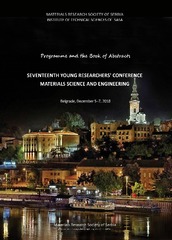Приказ основних података о документу
Synthesis and characterization of Na0.4MnO2 as cathode material for aqueous sodium-ion batteries
| dc.creator | Rakočević, Lazar | |
| dc.creator | Novaković, Mirjana | |
| dc.creator | Potočnik, Jelena | |
| dc.creator | Jugović, Dragana | |
| dc.creator | Stojković Simatović, Ivana | |
| dc.date.accessioned | 2018-12-29T16:16:34Z | |
| dc.date.available | 2018-12-29T16:16:34Z | |
| dc.date.issued | 2018 | |
| dc.identifier.isbn | 978-86-80321-34-9 | |
| dc.identifier.uri | https://dais.sanu.ac.rs/123456789/4726 | |
| dc.description.abstract | The application of rechargeable batteries is growing significantly and there is a need for developing cheaper batteries with good performances. Sodium-ion batteries could be a viable option due to higher abundance of sodium against lithium mineral resources, its low price and similar principles intercalate Na+ ions as Li+ ions in lithium-ion batteries. Different materials as manganese oxides and vanadium oxide are used as electrode materials in sodium batteries. Na0.44MnO2 was regarded as one of the most promising cathode materials for sodium-ion batteries due to its high specific capacity and good cyclability. In this work, Na0.4MnO2 was synthesized using glycine-nitrate method (GNM). The structure of synthesized powder was characterized by X-Ray Diffraction (XRD), while the particles morphology was examined by scanning electron microscopy (SEM) and transmission electron microscopy (TEM). The elemental mapping was performed by energy-dispersive Xray spectroscopy (EDS). XRD results showed that the phase structure of Na0.4MnO2 was orthorhombic with tunnel structure. TEM and SEM micrographs of obtained powder material showed uniformed rod-like shape particles with the average lengths and widths of 300 nm and 80 nm, respectively and EDS analysis confirmed that the sample contains Na, Mn, and O in an appropriate ration. The electrochemical behavior of Na0.4MnO2 was investigated by cyclic voltammetry (CV) in a saturated aqueous solution of NaNO3 at scan rates from 20 to 400 mV•s-1. The initial discharge capacity of Na0.4MnO2 in NaNO3 solution was 50 mA•h•g- 1, while after 15 cycles its value increased for 9%. while the efficiency (the ratio of the capacity charge and discharge) was amounting to ~ 95%. This indicates that material synthesized by GNM can be used as cathode material in aqueous sodium-ion batteries | en |
| dc.language.iso | en | sr |
| dc.publisher | Belgrade : Institute of Technical Sciences of SASA | sr |
| dc.relation | info:eu-repo/grantAgreement/MESTD/Integrated and Interdisciplinary Research (IIR or III)/45014/RS// | sr |
| dc.rights | openAccess | sr |
| dc.rights.uri | https://creativecommons.org/licenses/by-nc-nd/4.0/ | |
| dc.source | Program and the Book of Abstracts / Seventeenth Young Researchers' Conference Materials Sciences and Engineering, December 5-7, 2018, Belgrade, Serbia | sr |
| dc.subject | Na0.4MnO2 | sr |
| dc.subject | aqueous sodium-ion batteries | sr |
| dc.title | Synthesis and characterization of Na0.4MnO2 as cathode material for aqueous sodium-ion batteries | en |
| dc.type | conferenceObject | sr |
| dc.rights.license | BY-NC-ND | sr |
| dcterms.abstract | Ракочевић, Лазар; Новаковић, Мирјана; Поточник, Јелена; Стојковић Симатовић, Ивана; Југовић, Драгана; | |
| dc.citation.spage | 48 | |
| dc.citation.epage | 48 | |
| dc.type.version | publishedVersion | sr |
| dc.identifier.fulltext | https://dais.sanu.ac.rs/bitstream/id/14745/Rakocevic-17YRC2018-5.pdf | |
| dc.identifier.rcub | https://hdl.handle.net/21.15107/rcub_dais_4726 |

